Impact of Transportation on Health: A Detailed Report, Semester 2
VerifiedAdded on 2022/09/16
|10
|2484
|26
Report
AI Summary
This report delves into the multifaceted relationship between transportation and health, highlighting its profound impact on both individual and community well-being. It emphasizes how transportation, as a social determinant of health, influences access to essential services like healthcare, healthy food, and employment, particularly affecting vulnerable populations such as the elderly, low-income individuals, and those in rural areas. The report explores the adverse health consequences of motorized transportation, including air pollution, traffic crashes, and physical inactivity, while also advocating for alternative transportation options. It examines how transportation affects various aspects of life, from accessing healthcare to economic mobility, and discusses the role of transportation in influencing health outcomes. The report underscores the importance of convenient and affordable transportation systems in promoting health equity, reducing healthcare costs, and improving overall quality of life. It also provides data on how transportation challenges can lead to missed medical appointments and decreased access to pharmacy services. The report concludes by emphasizing the need for government initiatives to support and improve public transportation for the betterment of public health and well-being.
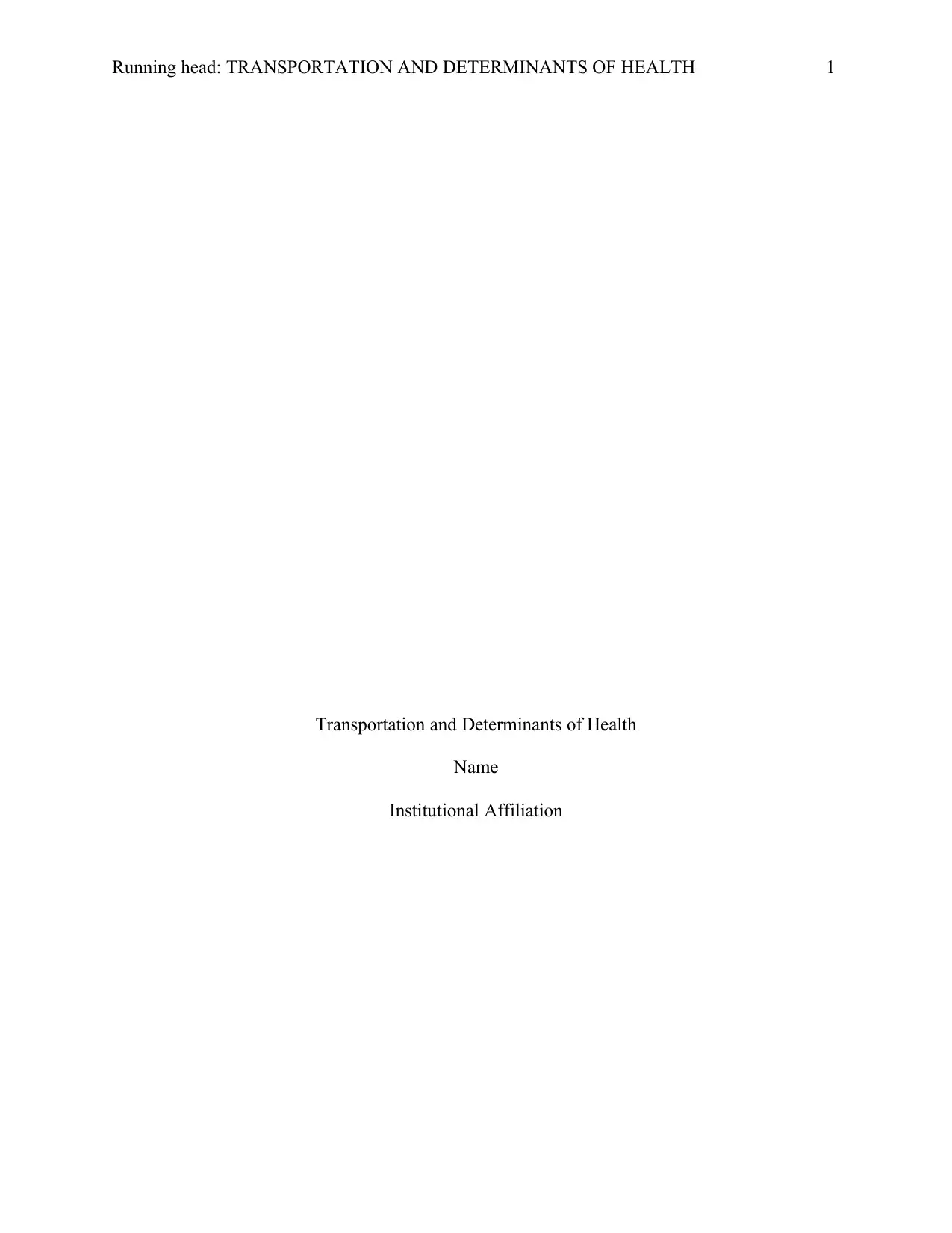
Running head: TRANSPORTATION AND DETERMINANTS OF HEALTH 1
Transportation and Determinants of Health
Name
Institutional Affiliation
Transportation and Determinants of Health
Name
Institutional Affiliation
Paraphrase This Document
Need a fresh take? Get an instant paraphrase of this document with our AI Paraphraser
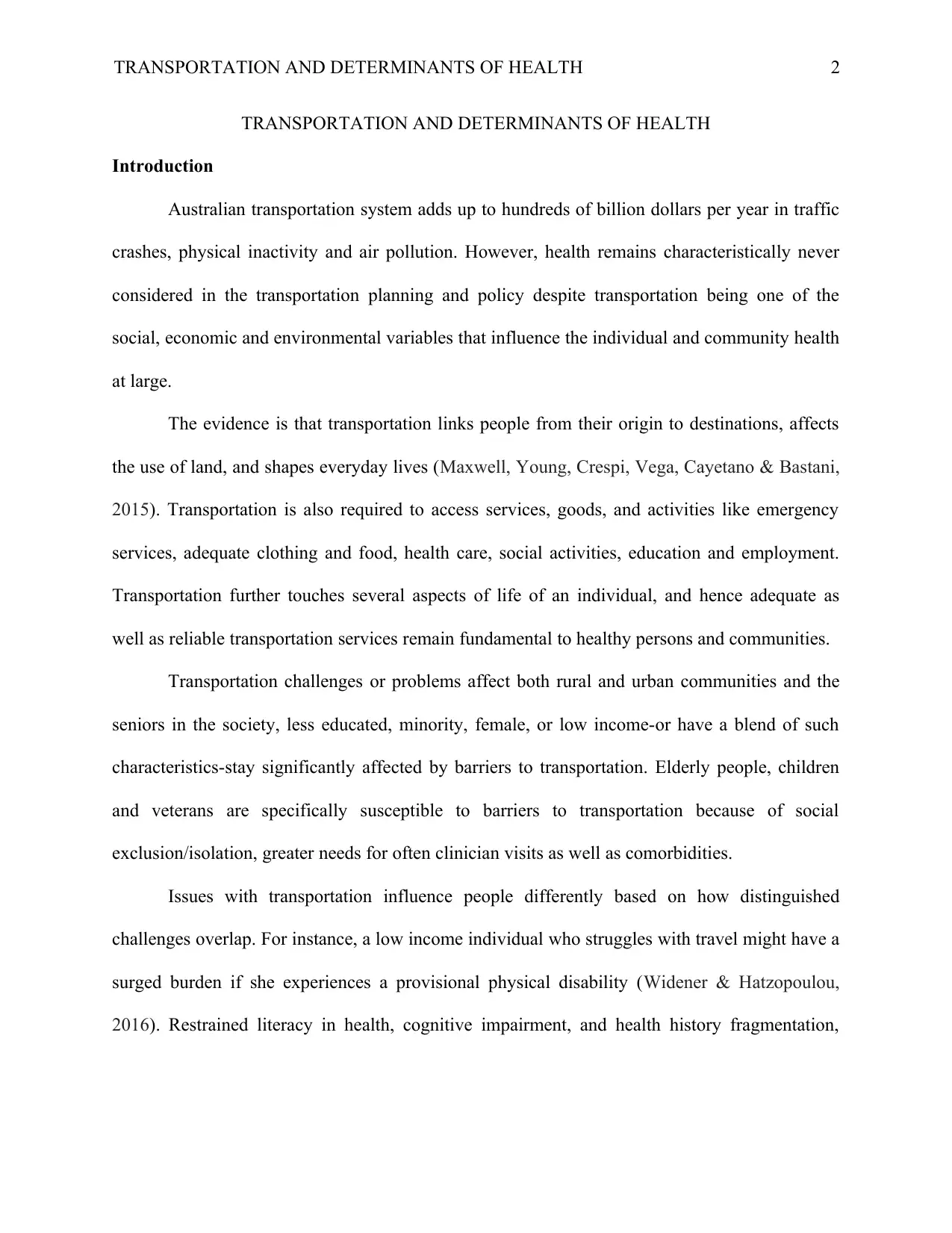
TRANSPORTATION AND DETERMINANTS OF HEALTH 2
TRANSPORTATION AND DETERMINANTS OF HEALTH
Introduction
Australian transportation system adds up to hundreds of billion dollars per year in traffic
crashes, physical inactivity and air pollution. However, health remains characteristically never
considered in the transportation planning and policy despite transportation being one of the
social, economic and environmental variables that influence the individual and community health
at large.
The evidence is that transportation links people from their origin to destinations, affects
the use of land, and shapes everyday lives (Maxwell, Young, Crespi, Vega, Cayetano & Bastani,
2015). Transportation is also required to access services, goods, and activities like emergency
services, adequate clothing and food, health care, social activities, education and employment.
Transportation further touches several aspects of life of an individual, and hence adequate as
well as reliable transportation services remain fundamental to healthy persons and communities.
Transportation challenges or problems affect both rural and urban communities and the
seniors in the society, less educated, minority, female, or low income-or have a blend of such
characteristics-stay significantly affected by barriers to transportation. Elderly people, children
and veterans are specifically susceptible to barriers to transportation because of social
exclusion/isolation, greater needs for often clinician visits as well as comorbidities.
Issues with transportation influence people differently based on how distinguished
challenges overlap. For instance, a low income individual who struggles with travel might have a
surged burden if she experiences a provisional physical disability (Widener & Hatzopoulou,
2016). Restrained literacy in health, cognitive impairment, and health history fragmentation,
TRANSPORTATION AND DETERMINANTS OF HEALTH
Introduction
Australian transportation system adds up to hundreds of billion dollars per year in traffic
crashes, physical inactivity and air pollution. However, health remains characteristically never
considered in the transportation planning and policy despite transportation being one of the
social, economic and environmental variables that influence the individual and community health
at large.
The evidence is that transportation links people from their origin to destinations, affects
the use of land, and shapes everyday lives (Maxwell, Young, Crespi, Vega, Cayetano & Bastani,
2015). Transportation is also required to access services, goods, and activities like emergency
services, adequate clothing and food, health care, social activities, education and employment.
Transportation further touches several aspects of life of an individual, and hence adequate as
well as reliable transportation services remain fundamental to healthy persons and communities.
Transportation challenges or problems affect both rural and urban communities and the
seniors in the society, less educated, minority, female, or low income-or have a blend of such
characteristics-stay significantly affected by barriers to transportation. Elderly people, children
and veterans are specifically susceptible to barriers to transportation because of social
exclusion/isolation, greater needs for often clinician visits as well as comorbidities.
Issues with transportation influence people differently based on how distinguished
challenges overlap. For instance, a low income individual who struggles with travel might have a
surged burden if she experiences a provisional physical disability (Widener & Hatzopoulou,
2016). Restrained literacy in health, cognitive impairment, and health history fragmentation,
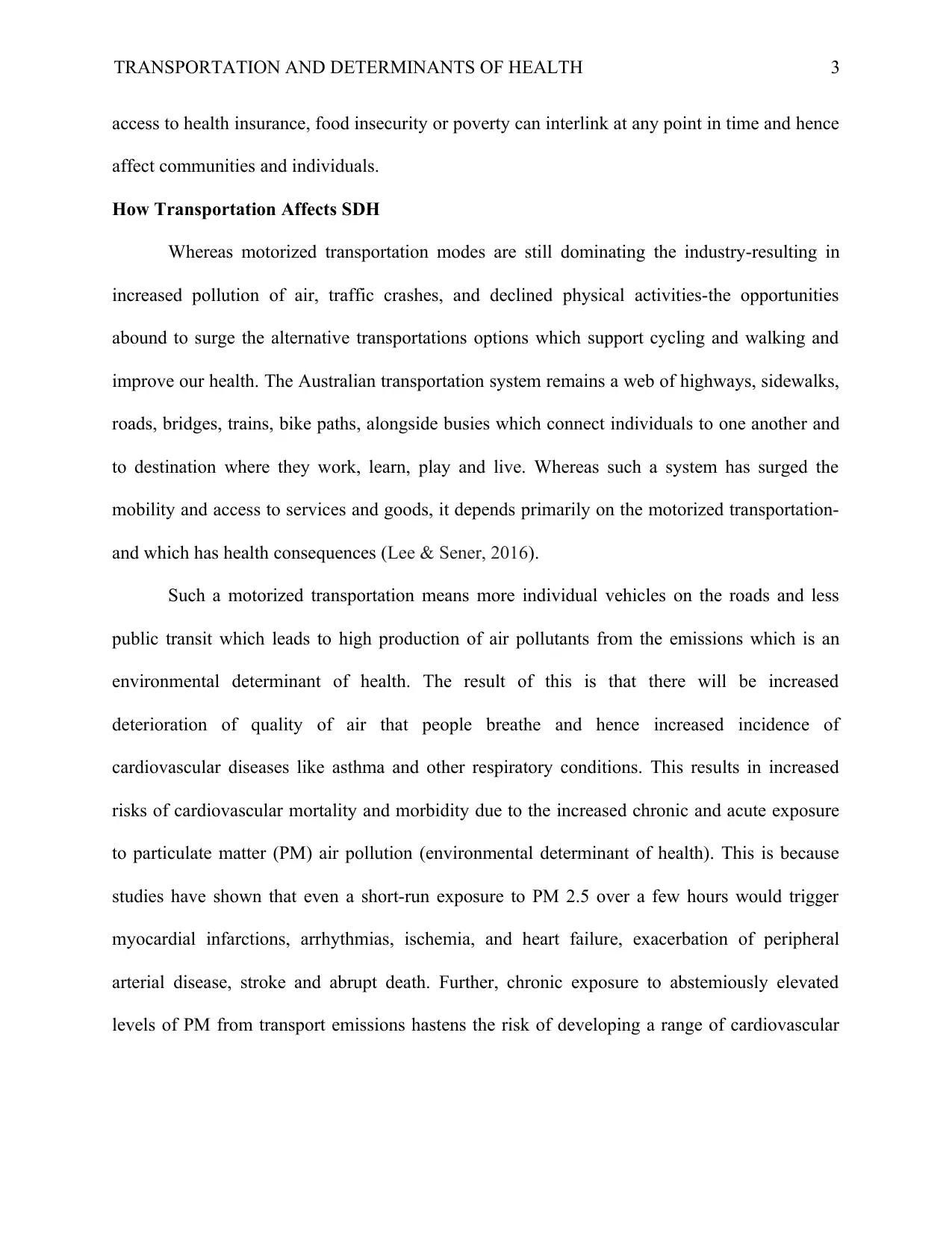
TRANSPORTATION AND DETERMINANTS OF HEALTH 3
access to health insurance, food insecurity or poverty can interlink at any point in time and hence
affect communities and individuals.
How Transportation Affects SDH
Whereas motorized transportation modes are still dominating the industry-resulting in
increased pollution of air, traffic crashes, and declined physical activities-the opportunities
abound to surge the alternative transportations options which support cycling and walking and
improve our health. The Australian transportation system remains a web of highways, sidewalks,
roads, bridges, trains, bike paths, alongside busies which connect individuals to one another and
to destination where they work, learn, play and live. Whereas such a system has surged the
mobility and access to services and goods, it depends primarily on the motorized transportation-
and which has health consequences (Lee & Sener, 2016).
Such a motorized transportation means more individual vehicles on the roads and less
public transit which leads to high production of air pollutants from the emissions which is an
environmental determinant of health. The result of this is that there will be increased
deterioration of quality of air that people breathe and hence increased incidence of
cardiovascular diseases like asthma and other respiratory conditions. This results in increased
risks of cardiovascular mortality and morbidity due to the increased chronic and acute exposure
to particulate matter (PM) air pollution (environmental determinant of health). This is because
studies have shown that even a short-run exposure to PM 2.5 over a few hours would trigger
myocardial infarctions, arrhythmias, ischemia, and heart failure, exacerbation of peripheral
arterial disease, stroke and abrupt death. Further, chronic exposure to abstemiously elevated
levels of PM from transport emissions hastens the risk of developing a range of cardiovascular
access to health insurance, food insecurity or poverty can interlink at any point in time and hence
affect communities and individuals.
How Transportation Affects SDH
Whereas motorized transportation modes are still dominating the industry-resulting in
increased pollution of air, traffic crashes, and declined physical activities-the opportunities
abound to surge the alternative transportations options which support cycling and walking and
improve our health. The Australian transportation system remains a web of highways, sidewalks,
roads, bridges, trains, bike paths, alongside busies which connect individuals to one another and
to destination where they work, learn, play and live. Whereas such a system has surged the
mobility and access to services and goods, it depends primarily on the motorized transportation-
and which has health consequences (Lee & Sener, 2016).
Such a motorized transportation means more individual vehicles on the roads and less
public transit which leads to high production of air pollutants from the emissions which is an
environmental determinant of health. The result of this is that there will be increased
deterioration of quality of air that people breathe and hence increased incidence of
cardiovascular diseases like asthma and other respiratory conditions. This results in increased
risks of cardiovascular mortality and morbidity due to the increased chronic and acute exposure
to particulate matter (PM) air pollution (environmental determinant of health). This is because
studies have shown that even a short-run exposure to PM 2.5 over a few hours would trigger
myocardial infarctions, arrhythmias, ischemia, and heart failure, exacerbation of peripheral
arterial disease, stroke and abrupt death. Further, chronic exposure to abstemiously elevated
levels of PM from transport emissions hastens the risk of developing a range of cardiovascular
⊘ This is a preview!⊘
Do you want full access?
Subscribe today to unlock all pages.

Trusted by 1+ million students worldwide
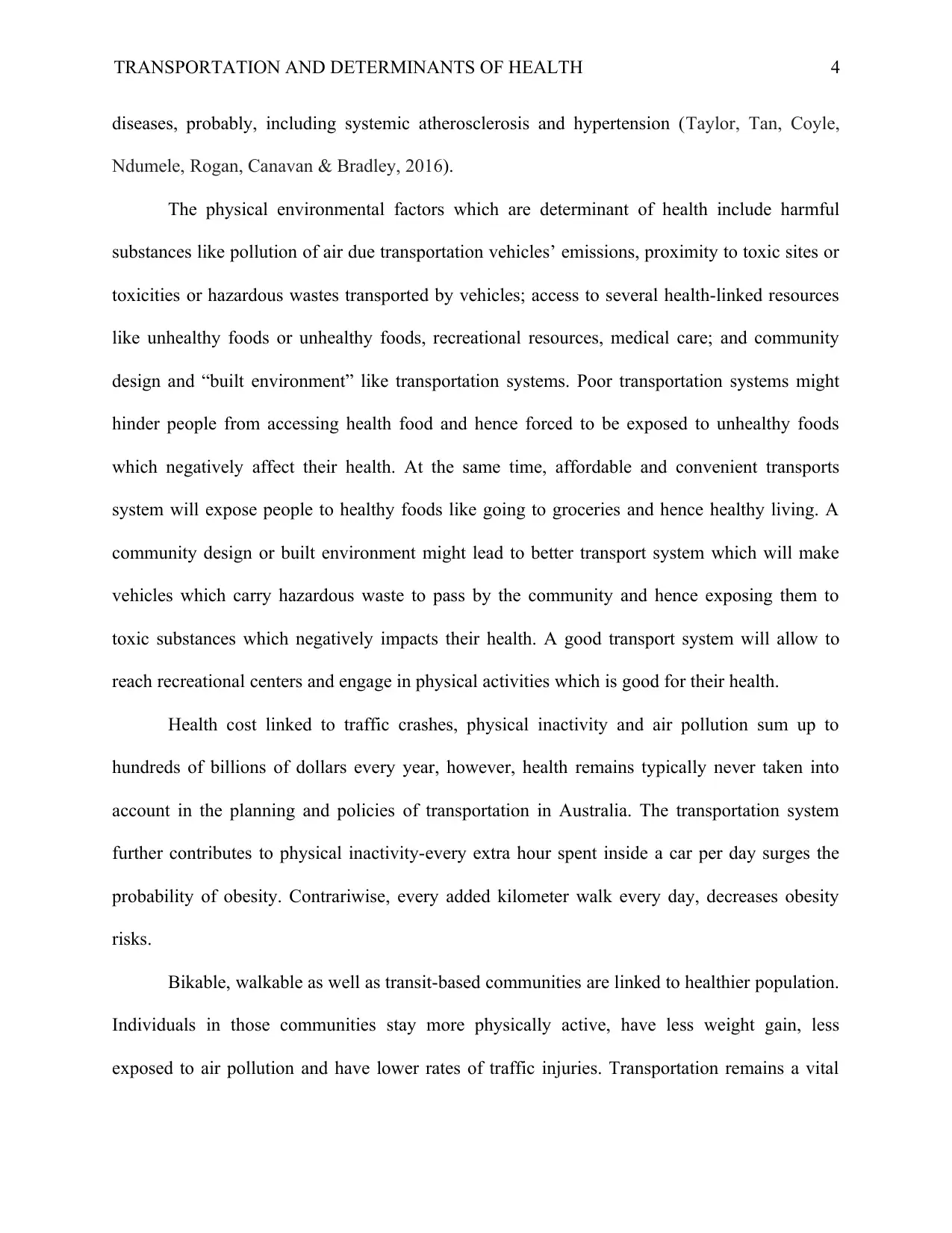
TRANSPORTATION AND DETERMINANTS OF HEALTH 4
diseases, probably, including systemic atherosclerosis and hypertension (Taylor, Tan, Coyle,
Ndumele, Rogan, Canavan & Bradley, 2016).
The physical environmental factors which are determinant of health include harmful
substances like pollution of air due transportation vehicles’ emissions, proximity to toxic sites or
toxicities or hazardous wastes transported by vehicles; access to several health-linked resources
like unhealthy foods or unhealthy foods, recreational resources, medical care; and community
design and “built environment” like transportation systems. Poor transportation systems might
hinder people from accessing health food and hence forced to be exposed to unhealthy foods
which negatively affect their health. At the same time, affordable and convenient transports
system will expose people to healthy foods like going to groceries and hence healthy living. A
community design or built environment might lead to better transport system which will make
vehicles which carry hazardous waste to pass by the community and hence exposing them to
toxic substances which negatively impacts their health. A good transport system will allow to
reach recreational centers and engage in physical activities which is good for their health.
Health cost linked to traffic crashes, physical inactivity and air pollution sum up to
hundreds of billions of dollars every year, however, health remains typically never taken into
account in the planning and policies of transportation in Australia. The transportation system
further contributes to physical inactivity-every extra hour spent inside a car per day surges the
probability of obesity. Contrariwise, every added kilometer walk every day, decreases obesity
risks.
Bikable, walkable as well as transit-based communities are linked to healthier population.
Individuals in those communities stay more physically active, have less weight gain, less
exposed to air pollution and have lower rates of traffic injuries. Transportation remains a vital
diseases, probably, including systemic atherosclerosis and hypertension (Taylor, Tan, Coyle,
Ndumele, Rogan, Canavan & Bradley, 2016).
The physical environmental factors which are determinant of health include harmful
substances like pollution of air due transportation vehicles’ emissions, proximity to toxic sites or
toxicities or hazardous wastes transported by vehicles; access to several health-linked resources
like unhealthy foods or unhealthy foods, recreational resources, medical care; and community
design and “built environment” like transportation systems. Poor transportation systems might
hinder people from accessing health food and hence forced to be exposed to unhealthy foods
which negatively affect their health. At the same time, affordable and convenient transports
system will expose people to healthy foods like going to groceries and hence healthy living. A
community design or built environment might lead to better transport system which will make
vehicles which carry hazardous waste to pass by the community and hence exposing them to
toxic substances which negatively impacts their health. A good transport system will allow to
reach recreational centers and engage in physical activities which is good for their health.
Health cost linked to traffic crashes, physical inactivity and air pollution sum up to
hundreds of billions of dollars every year, however, health remains typically never taken into
account in the planning and policies of transportation in Australia. The transportation system
further contributes to physical inactivity-every extra hour spent inside a car per day surges the
probability of obesity. Contrariwise, every added kilometer walk every day, decreases obesity
risks.
Bikable, walkable as well as transit-based communities are linked to healthier population.
Individuals in those communities stay more physically active, have less weight gain, less
exposed to air pollution and have lower rates of traffic injuries. Transportation remains a vital
Paraphrase This Document
Need a fresh take? Get an instant paraphrase of this document with our AI Paraphraser
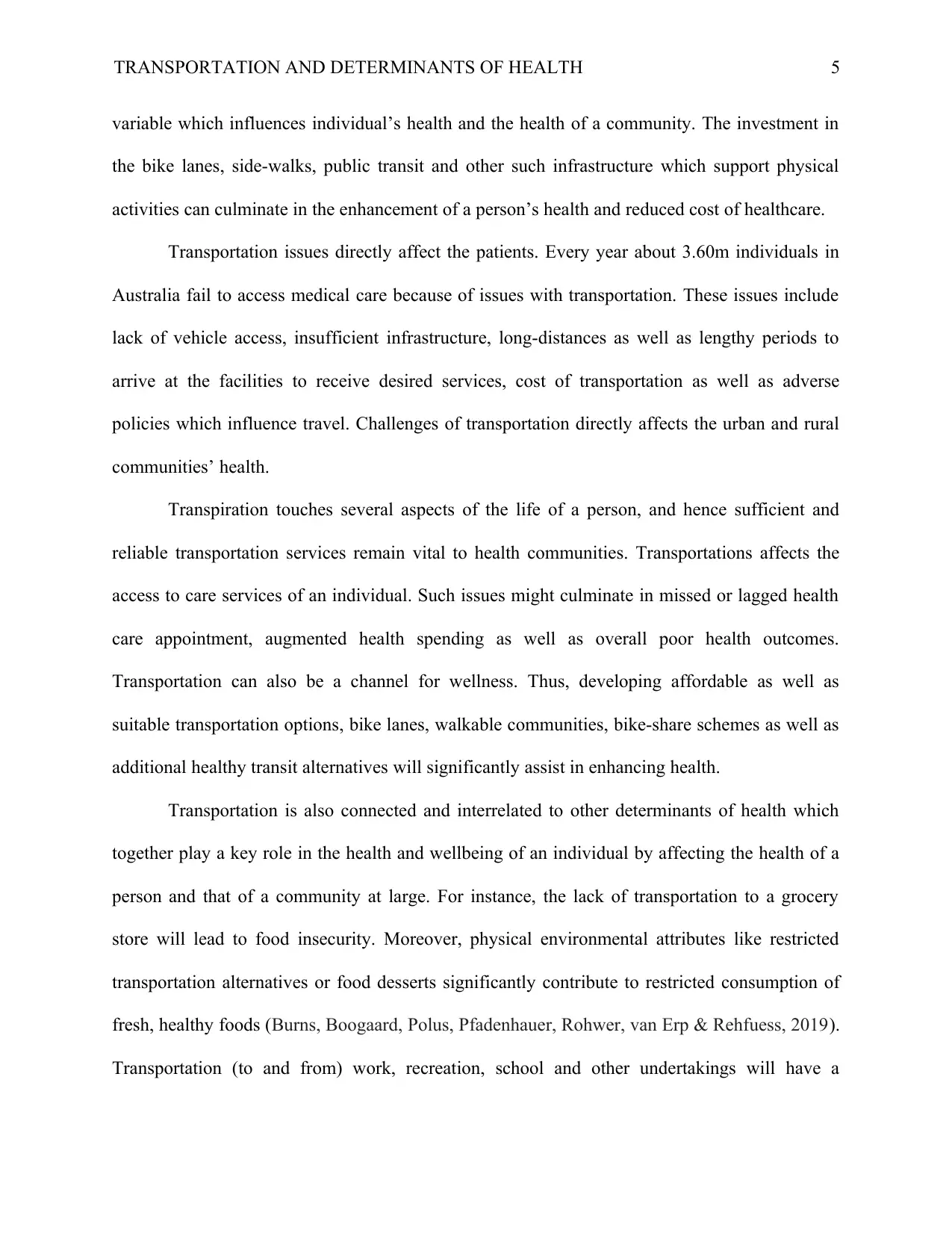
TRANSPORTATION AND DETERMINANTS OF HEALTH 5
variable which influences individual’s health and the health of a community. The investment in
the bike lanes, side-walks, public transit and other such infrastructure which support physical
activities can culminate in the enhancement of a person’s health and reduced cost of healthcare.
Transportation issues directly affect the patients. Every year about 3.60m individuals in
Australia fail to access medical care because of issues with transportation. These issues include
lack of vehicle access, insufficient infrastructure, long-distances as well as lengthy periods to
arrive at the facilities to receive desired services, cost of transportation as well as adverse
policies which influence travel. Challenges of transportation directly affects the urban and rural
communities’ health.
Transpiration touches several aspects of the life of a person, and hence sufficient and
reliable transportation services remain vital to health communities. Transportations affects the
access to care services of an individual. Such issues might culminate in missed or lagged health
care appointment, augmented health spending as well as overall poor health outcomes.
Transportation can also be a channel for wellness. Thus, developing affordable as well as
suitable transportation options, bike lanes, walkable communities, bike-share schemes as well as
additional healthy transit alternatives will significantly assist in enhancing health.
Transportation is also connected and interrelated to other determinants of health which
together play a key role in the health and wellbeing of an individual by affecting the health of a
person and that of a community at large. For instance, the lack of transportation to a grocery
store will lead to food insecurity. Moreover, physical environmental attributes like restricted
transportation alternatives or food desserts significantly contribute to restricted consumption of
fresh, healthy foods (Burns, Boogaard, Polus, Pfadenhauer, Rohwer, van Erp & Rehfuess, 2019).
Transportation (to and from) work, recreation, school and other undertakings will have a
variable which influences individual’s health and the health of a community. The investment in
the bike lanes, side-walks, public transit and other such infrastructure which support physical
activities can culminate in the enhancement of a person’s health and reduced cost of healthcare.
Transportation issues directly affect the patients. Every year about 3.60m individuals in
Australia fail to access medical care because of issues with transportation. These issues include
lack of vehicle access, insufficient infrastructure, long-distances as well as lengthy periods to
arrive at the facilities to receive desired services, cost of transportation as well as adverse
policies which influence travel. Challenges of transportation directly affects the urban and rural
communities’ health.
Transpiration touches several aspects of the life of a person, and hence sufficient and
reliable transportation services remain vital to health communities. Transportations affects the
access to care services of an individual. Such issues might culminate in missed or lagged health
care appointment, augmented health spending as well as overall poor health outcomes.
Transportation can also be a channel for wellness. Thus, developing affordable as well as
suitable transportation options, bike lanes, walkable communities, bike-share schemes as well as
additional healthy transit alternatives will significantly assist in enhancing health.
Transportation is also connected and interrelated to other determinants of health which
together play a key role in the health and wellbeing of an individual by affecting the health of a
person and that of a community at large. For instance, the lack of transportation to a grocery
store will lead to food insecurity. Moreover, physical environmental attributes like restricted
transportation alternatives or food desserts significantly contribute to restricted consumption of
fresh, healthy foods (Burns, Boogaard, Polus, Pfadenhauer, Rohwer, van Erp & Rehfuess, 2019).
Transportation (to and from) work, recreation, school and other undertakings will have a
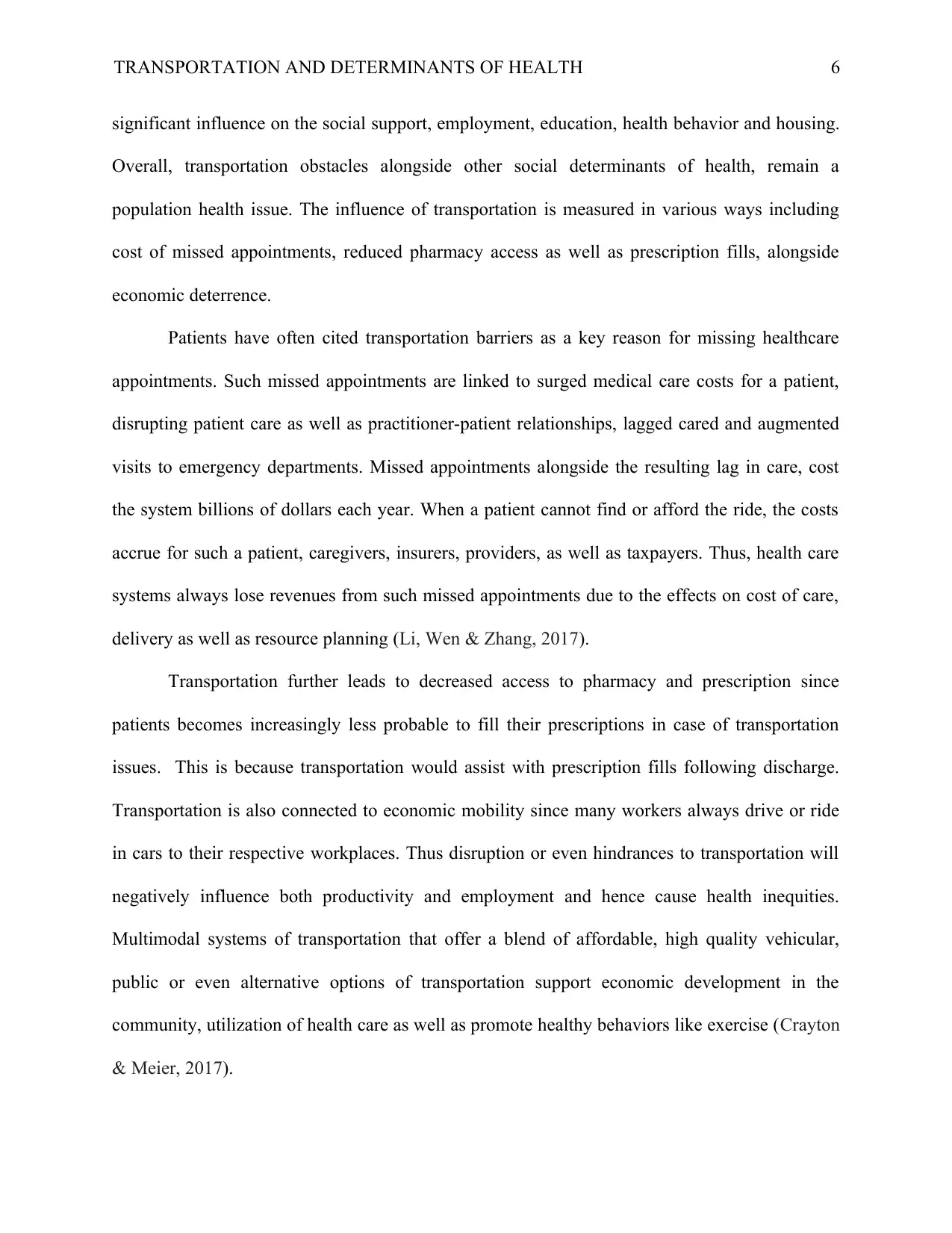
TRANSPORTATION AND DETERMINANTS OF HEALTH 6
significant influence on the social support, employment, education, health behavior and housing.
Overall, transportation obstacles alongside other social determinants of health, remain a
population health issue. The influence of transportation is measured in various ways including
cost of missed appointments, reduced pharmacy access as well as prescription fills, alongside
economic deterrence.
Patients have often cited transportation barriers as a key reason for missing healthcare
appointments. Such missed appointments are linked to surged medical care costs for a patient,
disrupting patient care as well as practitioner-patient relationships, lagged cared and augmented
visits to emergency departments. Missed appointments alongside the resulting lag in care, cost
the system billions of dollars each year. When a patient cannot find or afford the ride, the costs
accrue for such a patient, caregivers, insurers, providers, as well as taxpayers. Thus, health care
systems always lose revenues from such missed appointments due to the effects on cost of care,
delivery as well as resource planning (Li, Wen & Zhang, 2017).
Transportation further leads to decreased access to pharmacy and prescription since
patients becomes increasingly less probable to fill their prescriptions in case of transportation
issues. This is because transportation would assist with prescription fills following discharge.
Transportation is also connected to economic mobility since many workers always drive or ride
in cars to their respective workplaces. Thus disruption or even hindrances to transportation will
negatively influence both productivity and employment and hence cause health inequities.
Multimodal systems of transportation that offer a blend of affordable, high quality vehicular,
public or even alternative options of transportation support economic development in the
community, utilization of health care as well as promote healthy behaviors like exercise (Crayton
& Meier, 2017).
significant influence on the social support, employment, education, health behavior and housing.
Overall, transportation obstacles alongside other social determinants of health, remain a
population health issue. The influence of transportation is measured in various ways including
cost of missed appointments, reduced pharmacy access as well as prescription fills, alongside
economic deterrence.
Patients have often cited transportation barriers as a key reason for missing healthcare
appointments. Such missed appointments are linked to surged medical care costs for a patient,
disrupting patient care as well as practitioner-patient relationships, lagged cared and augmented
visits to emergency departments. Missed appointments alongside the resulting lag in care, cost
the system billions of dollars each year. When a patient cannot find or afford the ride, the costs
accrue for such a patient, caregivers, insurers, providers, as well as taxpayers. Thus, health care
systems always lose revenues from such missed appointments due to the effects on cost of care,
delivery as well as resource planning (Li, Wen & Zhang, 2017).
Transportation further leads to decreased access to pharmacy and prescription since
patients becomes increasingly less probable to fill their prescriptions in case of transportation
issues. This is because transportation would assist with prescription fills following discharge.
Transportation is also connected to economic mobility since many workers always drive or ride
in cars to their respective workplaces. Thus disruption or even hindrances to transportation will
negatively influence both productivity and employment and hence cause health inequities.
Multimodal systems of transportation that offer a blend of affordable, high quality vehicular,
public or even alternative options of transportation support economic development in the
community, utilization of health care as well as promote healthy behaviors like exercise (Crayton
& Meier, 2017).
⊘ This is a preview!⊘
Do you want full access?
Subscribe today to unlock all pages.

Trusted by 1+ million students worldwide
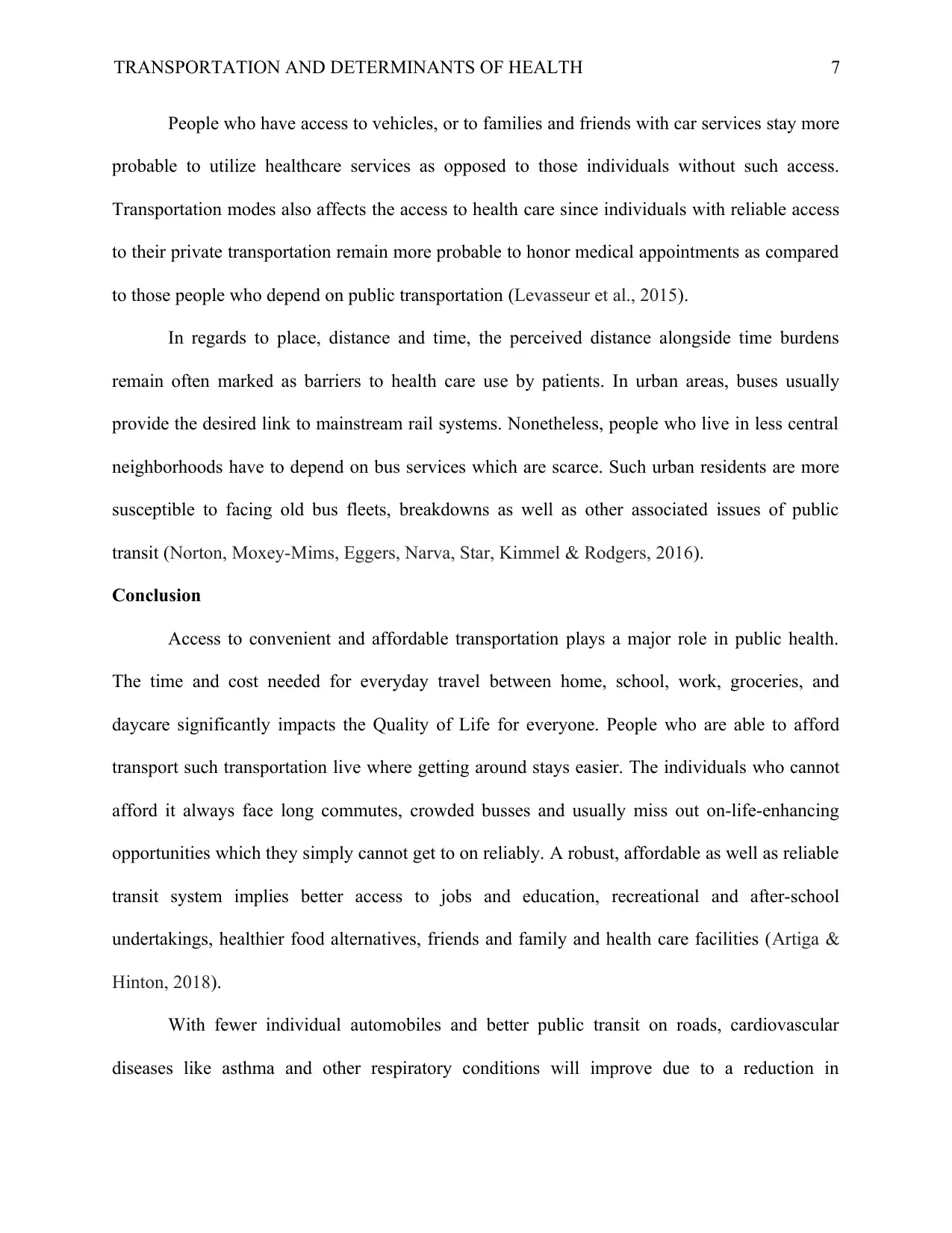
TRANSPORTATION AND DETERMINANTS OF HEALTH 7
People who have access to vehicles, or to families and friends with car services stay more
probable to utilize healthcare services as opposed to those individuals without such access.
Transportation modes also affects the access to health care since individuals with reliable access
to their private transportation remain more probable to honor medical appointments as compared
to those people who depend on public transportation (Levasseur et al., 2015).
In regards to place, distance and time, the perceived distance alongside time burdens
remain often marked as barriers to health care use by patients. In urban areas, buses usually
provide the desired link to mainstream rail systems. Nonetheless, people who live in less central
neighborhoods have to depend on bus services which are scarce. Such urban residents are more
susceptible to facing old bus fleets, breakdowns as well as other associated issues of public
transit (Norton, Moxey-Mims, Eggers, Narva, Star, Kimmel & Rodgers, 2016).
Conclusion
Access to convenient and affordable transportation plays a major role in public health.
The time and cost needed for everyday travel between home, school, work, groceries, and
daycare significantly impacts the Quality of Life for everyone. People who are able to afford
transport such transportation live where getting around stays easier. The individuals who cannot
afford it always face long commutes, crowded busses and usually miss out on-life-enhancing
opportunities which they simply cannot get to on reliably. A robust, affordable as well as reliable
transit system implies better access to jobs and education, recreational and after-school
undertakings, healthier food alternatives, friends and family and health care facilities (Artiga &
Hinton, 2018).
With fewer individual automobiles and better public transit on roads, cardiovascular
diseases like asthma and other respiratory conditions will improve due to a reduction in
People who have access to vehicles, or to families and friends with car services stay more
probable to utilize healthcare services as opposed to those individuals without such access.
Transportation modes also affects the access to health care since individuals with reliable access
to their private transportation remain more probable to honor medical appointments as compared
to those people who depend on public transportation (Levasseur et al., 2015).
In regards to place, distance and time, the perceived distance alongside time burdens
remain often marked as barriers to health care use by patients. In urban areas, buses usually
provide the desired link to mainstream rail systems. Nonetheless, people who live in less central
neighborhoods have to depend on bus services which are scarce. Such urban residents are more
susceptible to facing old bus fleets, breakdowns as well as other associated issues of public
transit (Norton, Moxey-Mims, Eggers, Narva, Star, Kimmel & Rodgers, 2016).
Conclusion
Access to convenient and affordable transportation plays a major role in public health.
The time and cost needed for everyday travel between home, school, work, groceries, and
daycare significantly impacts the Quality of Life for everyone. People who are able to afford
transport such transportation live where getting around stays easier. The individuals who cannot
afford it always face long commutes, crowded busses and usually miss out on-life-enhancing
opportunities which they simply cannot get to on reliably. A robust, affordable as well as reliable
transit system implies better access to jobs and education, recreational and after-school
undertakings, healthier food alternatives, friends and family and health care facilities (Artiga &
Hinton, 2018).
With fewer individual automobiles and better public transit on roads, cardiovascular
diseases like asthma and other respiratory conditions will improve due to a reduction in
Paraphrase This Document
Need a fresh take? Get an instant paraphrase of this document with our AI Paraphraser

TRANSPORTATION AND DETERMINANTS OF HEALTH 8
emissions. Access to affordable public transit further augments physical activities because there
is nearly always walking and biking linked to taking a train or bus. Thus, the government should
continue to work towards keeping public transportation affordable and convenient and encourage
its citizens to strive to make it better through proper use.
emissions. Access to affordable public transit further augments physical activities because there
is nearly always walking and biking linked to taking a train or bus. Thus, the government should
continue to work towards keeping public transportation affordable and convenient and encourage
its citizens to strive to make it better through proper use.
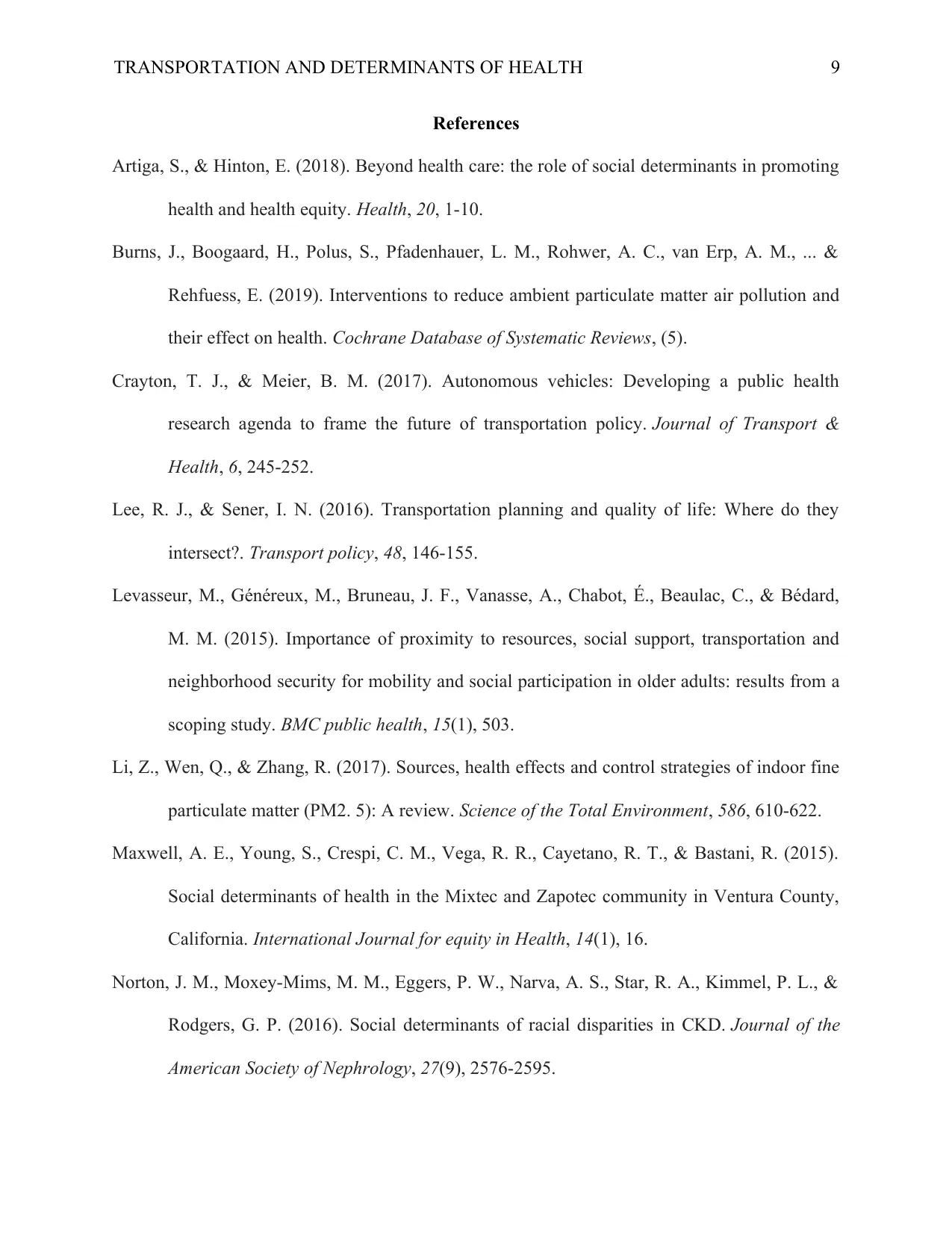
TRANSPORTATION AND DETERMINANTS OF HEALTH 9
References
Artiga, S., & Hinton, E. (2018). Beyond health care: the role of social determinants in promoting
health and health equity. Health, 20, 1-10.
Burns, J., Boogaard, H., Polus, S., Pfadenhauer, L. M., Rohwer, A. C., van Erp, A. M., ... &
Rehfuess, E. (2019). Interventions to reduce ambient particulate matter air pollution and
their effect on health. Cochrane Database of Systematic Reviews, (5).
Crayton, T. J., & Meier, B. M. (2017). Autonomous vehicles: Developing a public health
research agenda to frame the future of transportation policy. Journal of Transport &
Health, 6, 245-252.
Lee, R. J., & Sener, I. N. (2016). Transportation planning and quality of life: Where do they
intersect?. Transport policy, 48, 146-155.
Levasseur, M., Généreux, M., Bruneau, J. F., Vanasse, A., Chabot, É., Beaulac, C., & Bédard,
M. M. (2015). Importance of proximity to resources, social support, transportation and
neighborhood security for mobility and social participation in older adults: results from a
scoping study. BMC public health, 15(1), 503.
Li, Z., Wen, Q., & Zhang, R. (2017). Sources, health effects and control strategies of indoor fine
particulate matter (PM2. 5): A review. Science of the Total Environment, 586, 610-622.
Maxwell, A. E., Young, S., Crespi, C. M., Vega, R. R., Cayetano, R. T., & Bastani, R. (2015).
Social determinants of health in the Mixtec and Zapotec community in Ventura County,
California. International Journal for equity in Health, 14(1), 16.
Norton, J. M., Moxey-Mims, M. M., Eggers, P. W., Narva, A. S., Star, R. A., Kimmel, P. L., &
Rodgers, G. P. (2016). Social determinants of racial disparities in CKD. Journal of the
American Society of Nephrology, 27(9), 2576-2595.
References
Artiga, S., & Hinton, E. (2018). Beyond health care: the role of social determinants in promoting
health and health equity. Health, 20, 1-10.
Burns, J., Boogaard, H., Polus, S., Pfadenhauer, L. M., Rohwer, A. C., van Erp, A. M., ... &
Rehfuess, E. (2019). Interventions to reduce ambient particulate matter air pollution and
their effect on health. Cochrane Database of Systematic Reviews, (5).
Crayton, T. J., & Meier, B. M. (2017). Autonomous vehicles: Developing a public health
research agenda to frame the future of transportation policy. Journal of Transport &
Health, 6, 245-252.
Lee, R. J., & Sener, I. N. (2016). Transportation planning and quality of life: Where do they
intersect?. Transport policy, 48, 146-155.
Levasseur, M., Généreux, M., Bruneau, J. F., Vanasse, A., Chabot, É., Beaulac, C., & Bédard,
M. M. (2015). Importance of proximity to resources, social support, transportation and
neighborhood security for mobility and social participation in older adults: results from a
scoping study. BMC public health, 15(1), 503.
Li, Z., Wen, Q., & Zhang, R. (2017). Sources, health effects and control strategies of indoor fine
particulate matter (PM2. 5): A review. Science of the Total Environment, 586, 610-622.
Maxwell, A. E., Young, S., Crespi, C. M., Vega, R. R., Cayetano, R. T., & Bastani, R. (2015).
Social determinants of health in the Mixtec and Zapotec community in Ventura County,
California. International Journal for equity in Health, 14(1), 16.
Norton, J. M., Moxey-Mims, M. M., Eggers, P. W., Narva, A. S., Star, R. A., Kimmel, P. L., &
Rodgers, G. P. (2016). Social determinants of racial disparities in CKD. Journal of the
American Society of Nephrology, 27(9), 2576-2595.
⊘ This is a preview!⊘
Do you want full access?
Subscribe today to unlock all pages.

Trusted by 1+ million students worldwide
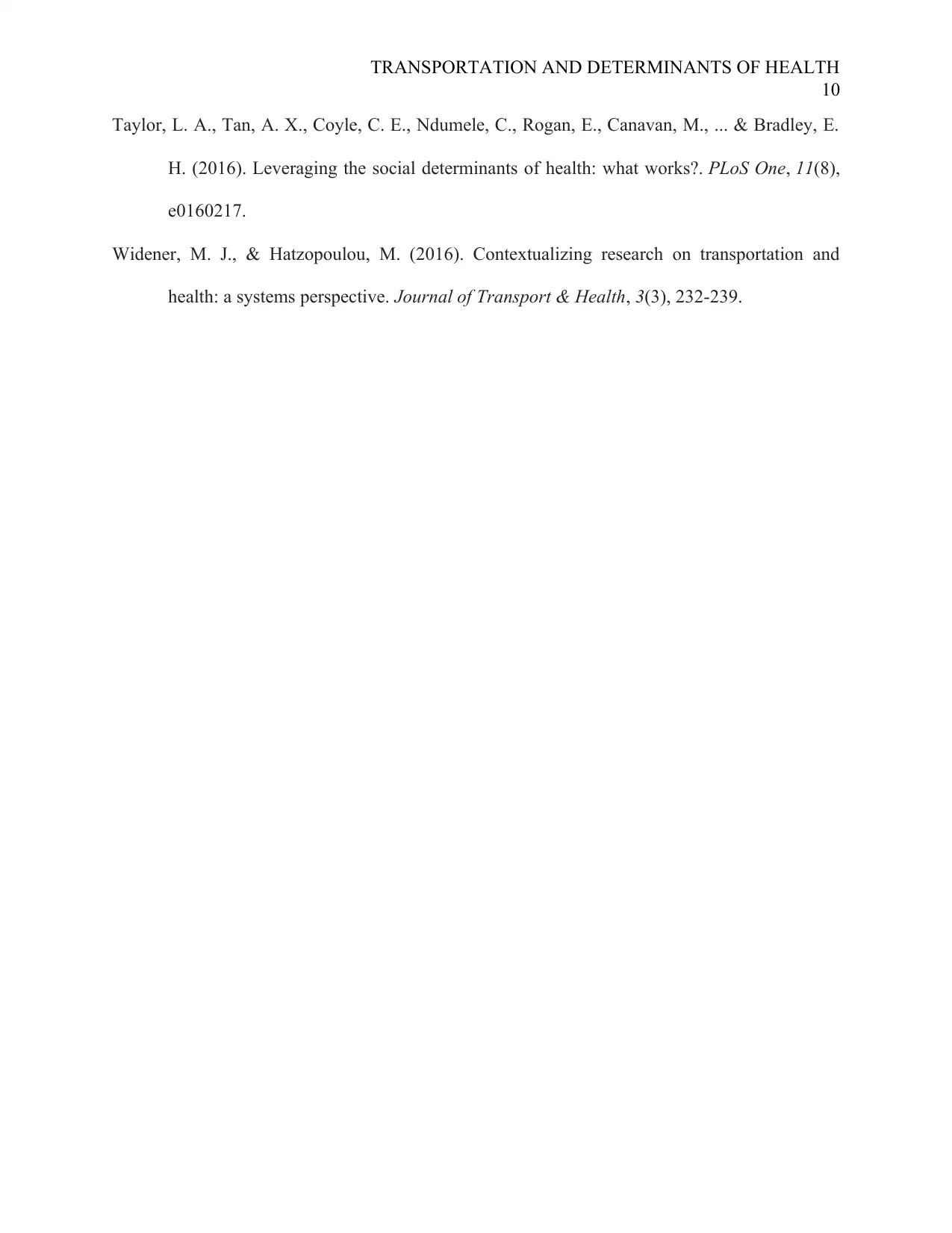
TRANSPORTATION AND DETERMINANTS OF HEALTH
10
Taylor, L. A., Tan, A. X., Coyle, C. E., Ndumele, C., Rogan, E., Canavan, M., ... & Bradley, E.
H. (2016). Leveraging the social determinants of health: what works?. PLoS One, 11(8),
e0160217.
Widener, M. J., & Hatzopoulou, M. (2016). Contextualizing research on transportation and
health: a systems perspective. Journal of Transport & Health, 3(3), 232-239.
10
Taylor, L. A., Tan, A. X., Coyle, C. E., Ndumele, C., Rogan, E., Canavan, M., ... & Bradley, E.
H. (2016). Leveraging the social determinants of health: what works?. PLoS One, 11(8),
e0160217.
Widener, M. J., & Hatzopoulou, M. (2016). Contextualizing research on transportation and
health: a systems perspective. Journal of Transport & Health, 3(3), 232-239.
1 out of 10
Related Documents
Your All-in-One AI-Powered Toolkit for Academic Success.
+13062052269
info@desklib.com
Available 24*7 on WhatsApp / Email
![[object Object]](/_next/static/media/star-bottom.7253800d.svg)
Unlock your academic potential
Copyright © 2020–2025 A2Z Services. All Rights Reserved. Developed and managed by ZUCOL.




